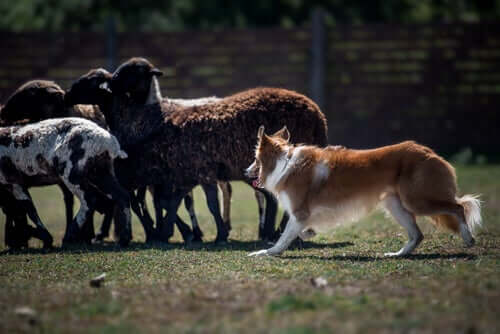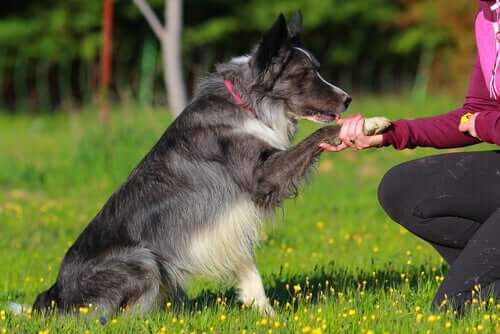Four Border Collie Herding Training Methods

Herding training methods are used on dogs that have a special predisposition to herding.
There are many easily lovable dog breeds. They have an obedient and disciplined nature to carry out many tasks, such as herding.
The Border Collie is a dog that was born to herd. No matter where it lives or who it has around it, it’ll always be herding, watching, and guarding.
Herding is more than simply taking cattle from one place to another; it’s also about nurturing and protecting.
This task is more complicated than it looks. Thus, if you want your Border Collie to be an excellent herder, you need to find a professional trainer that will teach it properly.
Although many choose to do it themselves, this isn’t an easy task, and will require the help of a professional to help you control your dog’s actions. Carrying it out in the right facilities will ensure your success.
Types of herding training for Border Collies
There are several types of herding training for Border Collies. Below, we’ll explain them in detail.
Obedience training
The first thing you must ensure is that your Border Collie responds to your orders through obedience training. Simple things such as an order to come, catch, release, or sit are essential before beginning herding training methods.
Your dog should walk calmly on a leash, staying in place and not running away the first chance it gets. If you haven’t yet achieved all this with your Border Collie, you must wait before starting herding training.
Don’t worry if you haven’t achieved it yet, as Border Collies are one of the most intelligent dog breeds. Thus, teaching your dog this order will be a simpler task than you may have imagined.

Voice training
Once your dog passes obedience training, it’s time that you start with basic herding training, in this case with voice commands.
Your dog should be able to distinguish the tones of your voice and know what you expect from it at all times, depending on your voice’s speed and intensity.
If you want your dog to move fast, you need to use a watered down and fast tone of voice. If you want it to slow down, you should lower your tone when you command it.
To correct your dog, you should use a high tone of voice. To attract your dog’s attention, whisper to it. Use short and precise words so the animal can understand what you need from it at all times.
Movement training
Although herding is instinctive in Border Collies, while it does this work it’ll always look at you waiting for your commands. Several studies have shown that shepherds and dogs communicate through looks and gestures rather than words.
You can teach your dog different gestures such as looking at it and also looking away to show you’re disappointed.

If you see that you’ve lost its attention, raise your hands and walk backward. The dog will understand that it’s done something wrong and that it needs your forgiveness and a new opportunity.
Herding
Once your dog has achieved the above three points, it’s ready to herd. You can count on it to group, lead, or enclose cattle.
Although this task isn’t deeply rooted in society nowadays, there’s no better dog than a Border Collie to do it. It’s in their blood, as it’s instinctive and part of them and their essence.
With these steps, training your Border Collie for herding will be much easier than you think.
Herding training methods are used on dogs that have a special predisposition to herding.
There are many easily lovable dog breeds. They have an obedient and disciplined nature to carry out many tasks, such as herding.
The Border Collie is a dog that was born to herd. No matter where it lives or who it has around it, it’ll always be herding, watching, and guarding.
Herding is more than simply taking cattle from one place to another; it’s also about nurturing and protecting.
This task is more complicated than it looks. Thus, if you want your Border Collie to be an excellent herder, you need to find a professional trainer that will teach it properly.
Although many choose to do it themselves, this isn’t an easy task, and will require the help of a professional to help you control your dog’s actions. Carrying it out in the right facilities will ensure your success.
Types of herding training for Border Collies
There are several types of herding training for Border Collies. Below, we’ll explain them in detail.
Obedience training
The first thing you must ensure is that your Border Collie responds to your orders through obedience training. Simple things such as an order to come, catch, release, or sit are essential before beginning herding training methods.
Your dog should walk calmly on a leash, staying in place and not running away the first chance it gets. If you haven’t yet achieved all this with your Border Collie, you must wait before starting herding training.
Don’t worry if you haven’t achieved it yet, as Border Collies are one of the most intelligent dog breeds. Thus, teaching your dog this order will be a simpler task than you may have imagined.

Voice training
Once your dog passes obedience training, it’s time that you start with basic herding training, in this case with voice commands.
Your dog should be able to distinguish the tones of your voice and know what you expect from it at all times, depending on your voice’s speed and intensity.
If you want your dog to move fast, you need to use a watered down and fast tone of voice. If you want it to slow down, you should lower your tone when you command it.
To correct your dog, you should use a high tone of voice. To attract your dog’s attention, whisper to it. Use short and precise words so the animal can understand what you need from it at all times.
Movement training
Although herding is instinctive in Border Collies, while it does this work it’ll always look at you waiting for your commands. Several studies have shown that shepherds and dogs communicate through looks and gestures rather than words.
You can teach your dog different gestures such as looking at it and also looking away to show you’re disappointed.

If you see that you’ve lost its attention, raise your hands and walk backward. The dog will understand that it’s done something wrong and that it needs your forgiveness and a new opportunity.
Herding
Once your dog has achieved the above three points, it’s ready to herd. You can count on it to group, lead, or enclose cattle.
Although this task isn’t deeply rooted in society nowadays, there’s no better dog than a Border Collie to do it. It’s in their blood, as it’s instinctive and part of them and their essence.
With these steps, training your Border Collie for herding will be much easier than you think.
All cited sources were thoroughly reviewed by our team to ensure their quality, reliability, currency, and validity. The bibliography of this article was considered reliable and of academic or scientific accuracy.
- Arnott, E. R., Early, J. B., Wade, C. M., & McGreevy, P. D. (2014). Environmental factors associated with success rates of Australian stock herding dogs. PloS one, 9(8), e104457. https://www.ncbi.nlm.nih.gov/pmc/articles/PMC4138039/
- Bray, E. E., Otto, C. M., Udell, M. A. R., Hall, N. J., Johnston, A. M., & MacLean, E. L. (2021). Enhancing the Selection and Performance of Working Dogs. Frontiers in veterinary science, 8, 644431. https://www.ncbi.nlm.nih.gov/pmc/articles/PMC8149746/
- Early, J., Aalders, J., Arnott, E., Wade, C., & McGreevy, P. (2020). Sequential Analysis of Livestock Herding Dog and Sheep Interactions. Animals: an open access journal from MDPI, 10(2), 352. https://www.ncbi.nlm.nih.gov/pmc/articles/PMC7070376/
- Federation Cynologique Internationale. (s.f.). Group 1: Sheepdogs and Cattledogs (except Swiss Cattledogs). (s.f.). Consultado el 5 de abril de 2023. https://www.fci.be/en/nomenclature/1-Sheepdogs-and-Cattledogs-except-Swiss-Cattledogs.html
- Ridgway M. (2021). Herding Dogs. The Veterinary clinics of North America. Small animal practice, 51(4), 975–984. https://pubmed.ncbi.nlm.nih.gov/34059268/
- Rogers, T. (s.f.). Creating a Confident Herding Partner. American Kennel Club. Consultado el 5 de abril de 2023. https://www.akc.org/sports/herding/articles/creating-a-confident-herding-partner/
- Rowlands, R. (2022). High-Energy Herding Dog Activities. AKC Pet Insurance.
https://www.akcpetinsurance.com/blog/herding-dogs-how-to-keep-your-highenergy-shepherd-or-cattle-dog-active-when-theyre-not-working
This text is provided for informational purposes only and does not replace consultation with a professional. If in doubt, consult your specialist.








